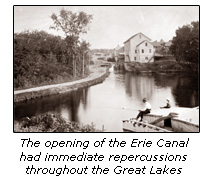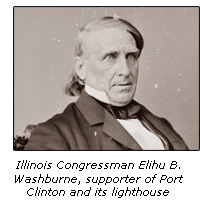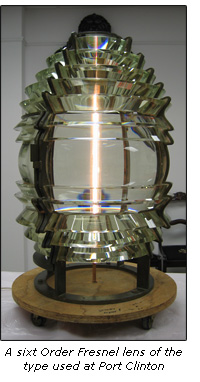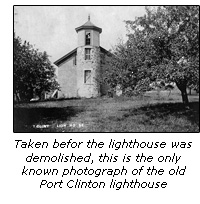|
Historical Information  The
1850’s were clearly destined to be a decade of unprecedented growth
throughout the western Great Lakes. A growing number of vessels were
being built to carry lumber from forest to growing cities along the
shores. A throng of immigrants were heading along the Erie Canal,
through Buffalo to seek new lives on the frontier, and with the planned
opening of the new lock at Sault Ste. Marie, shipments of copper, iron
and grain would soon be heading down the river from Lake Superior bound
for Chicago, Detroit and the growing industrial centers in the east. To
take advantage of this burgeoning population and trade potential,
speculators and investors were searching throughout the area for
locations in which to establish new towns, each of them firmly
convinced that their infant communities would become the “next
Chicago.” The
1850’s were clearly destined to be a decade of unprecedented growth
throughout the western Great Lakes. A growing number of vessels were
being built to carry lumber from forest to growing cities along the
shores. A throng of immigrants were heading along the Erie Canal,
through Buffalo to seek new lives on the frontier, and with the planned
opening of the new lock at Sault Ste. Marie, shipments of copper, iron
and grain would soon be heading down the river from Lake Superior bound
for Chicago, Detroit and the growing industrial centers in the east. To
take advantage of this burgeoning population and trade potential,
speculators and investors were searching throughout the area for
locations in which to establish new towns, each of them firmly
convinced that their infant communities would become the “next
Chicago.”  It
was such a dream that brought German immigrants John Hettinger and John
Peterman to a high bluff approximately 23 miles north of Chicago in
1847 where they platted their community of St. John. Although over the
following three years they established a brickyard and a 450-foot pier
on the lakeshore, a lack of connecting roads to the north and south
barred the town's growth, and they sold their interests in the town to
John Clinton Bloom in 1850. Bloom immediately renamed the town as "Port
Clinton" in his own honor, and seeking to capitalize on the seemingly
endless forests to the west, Bloom and his partners set up large
sawmill which by 1853 was supplying lumber to fuel the Chicago building
boom. It
was such a dream that brought German immigrants John Hettinger and John
Peterman to a high bluff approximately 23 miles north of Chicago in
1847 where they platted their community of St. John. Although over the
following three years they established a brickyard and a 450-foot pier
on the lakeshore, a lack of connecting roads to the north and south
barred the town's growth, and they sold their interests in the town to
John Clinton Bloom in 1850. Bloom immediately renamed the town as "Port
Clinton" in his own honor, and seeking to capitalize on the seemingly
endless forests to the west, Bloom and his partners set up large
sawmill which by 1853 was supplying lumber to fuel the Chicago building
boom. Likely
as a result of political pressure applied by Bloom and his associates
to provide an air of permanence and importance to their harbor, US
Representative Elihu B. Washburne introduced a bill before Congress
calling for the establishment of a lighthouse at Port Clinton on
December 6, 1853. After further pressure from fellow Illinois
Congressman Stephen A. Douglas in pushing the matter over the ensuing
year, Congress was finally convinced to pass an appropriation of $5,000
for the construction of a lighthouse at Port Clinton on August 3rd
1854. Likely
as a result of political pressure applied by Bloom and his associates
to provide an air of permanence and importance to their harbor, US
Representative Elihu B. Washburne introduced a bill before Congress
calling for the establishment of a lighthouse at Port Clinton on
December 6, 1853. After further pressure from fellow Illinois
Congressman Stephen A. Douglas in pushing the matter over the ensuing
year, Congress was finally convinced to pass an appropriation of $5,000
for the construction of a lighthouse at Port Clinton on August 3rd
1854.  A
contract for construction was awarded in 1855, and the work completed
the following year. The station took the form of a small but
substantial 1 ½-story brick dwelling with a cylindrical brick tower
connected at the center of its lakeward gable end. Capped by an
octagonal cast iron lantern housing a fixed white Sixth Order Fresnel
lens, the center of the lantern stood 22 feet above the tower’s
foundation. By virtue of its location atop a 52-foot bluff, the light
featured a focal plane of 70 feet, and was visible for 6 nautical miles
in clear weather. A
contract for construction was awarded in 1855, and the work completed
the following year. The station took the form of a small but
substantial 1 ½-story brick dwelling with a cylindrical brick tower
connected at the center of its lakeward gable end. Capped by an
octagonal cast iron lantern housing a fixed white Sixth Order Fresnel
lens, the center of the lantern stood 22 feet above the tower’s
foundation. By virtue of its location atop a 52-foot bluff, the light
featured a focal plane of 70 feet, and was visible for 6 nautical miles
in clear weather. While
Bloom continued to develop the area, building a grain elevator and
laying plank roads leading west into the wheat fields and south to
Chicago, a devastating outbreak of cholera in the area in 1854 killed
off many of the town’s occupants. After tracks were laid into the area
by the Chicago and Northwestern railroad, a much faster and less
expensive means for transporting area goods to the Windy City was
provided. As such, Port Clinton never grew to reach its expected
potential, and coming to the realization that the four year old
lighthouse was in reality serving no maritime commerce, the Lighthouse
Board closed the station in 1860. While
Bloom continued to develop the area, building a grain elevator and
laying plank roads leading west into the wheat fields and south to
Chicago, a devastating outbreak of cholera in the area in 1854 killed
off many of the town’s occupants. After tracks were laid into the area
by the Chicago and Northwestern railroad, a much faster and less
expensive means for transporting area goods to the Windy City was
provided. As such, Port Clinton never grew to reach its expected
potential, and coming to the realization that the four year old
lighthouse was in reality serving no maritime commerce, the Lighthouse
Board closed the station in 1860.The combination of the spreading growth of nearby Chicago and the existence of ready railroad transportation redefined the area over the ensuing decades. Renamed Highland Park, the area that was once Port Clinton developed into a residential bedroom community and resort area, with fine homes and hotels springing up to serve Chicago’s gentry.
Keepers of this Light Finding this Light |